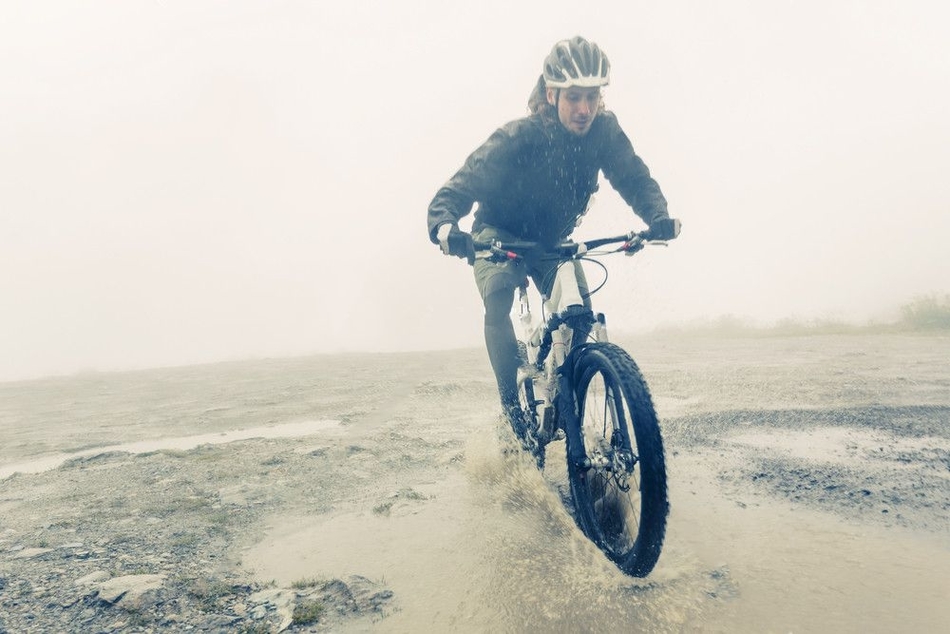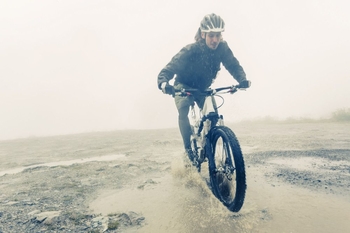
Lots of riders avoid going out in the rain to go mountain biking because they think it is too much trouble and dangerous. It is not going to be too much fun if you end up just walking with your bike on the trails. So I have come up with some tips to help you improve your experience when riding in the rain off road.
1. Use metallic brake pads
This is simple metallic brake pads are the best pads to use when the weather conditions are very bad. Especially when it is raining metallic pads will stop your bike better than any other option out there. Even in the wettest and muddiest conditions metallic is the way to go. Why.
Well the other type of brake pad is organic also known as a resin pad. This pad is made of a weaker material. During wet conditions if this pad is used in the rain it will provide very little braking power and you will keep going when you really want to slow down and or stop. Once these types of pads get wet they are pretty much useless.
These resin pads will lose power much faster than metallic pads especially when going down hill. The same thing happens if you are a heavier rider. It just can’t handle the weight long enough. Plus the longer you are braking the more friction builds up, which means heat. Metallic pads can handle the heat from friction. They last longer which saves you money, compared to resins pads which you will need to replace more often.
2. Use the right tires for rain
The best type of tires to have for wet, muddy, rainy conditions is tires which have tall knobs which are spaced widely apart. Tall knobs will increase the traction and the grip you need on the ground. These tall knobs will be able to grip themselves around roots, rock edges, and logs that you will find in your path on the trail. Extra grip is needed when they are wet.
The wider spacing of the knobs between them helps to fling of mud that builds up over time. If enough mud builds up and is not thrown off then essentially you will be riding on mud tires. Riding on mud tires will mean you will go nowhere fast and you will slip and slide if you have not slipped over already. As you pedal the mud has to be flung off with every stroke.
3. Reduce the pressure in your tires
Lowering the pressure in both the front tire and the rear tire will help to create more traction. You will need this extra traction to go over wet roots, rocks, branches, mud and water. Yes even water, that may seem crazy, right. Even water if your tires have no traction will cause your tires to slide out from under you.
How much should you reduce the pressure in your tires. You only need to lower the pressure by 2 or 3 psi, pounds per square inch. Your tires will then be able to conform themselves more around wet roots, rocks, and small obstacles, which will help to prevent you from slipping. This extra traction will also help you to go faster over them, compared to if the psi were higher. With a higher psi you would need to slow down considerably as you would bounce too much.
4. Use Flat Pedals
If you use clipless pedals you should switch to flat pedals for when it is raining. Clipless pedals after just a short time will get clogged up with mud. This will throw your cadence and you won’t feel as comfortable pedaling with mud clogged in there. Plus if you run into any trouble there is a delay in getting your foot detached from the pedal, this could cause a crash.
On the other hand using flat pedals ensures your pedals will not get clogged up. Even as mud may spray up to the flat pedals the rain water will immediately wash it away. If you do run into problems you can stick out your left or right foot to balance yourself and to keep yourself upright.
5. Use Eye Protection
Bicycle eyeglasses are a great idea especially when you are going downhill. This is because this is the best time to get things flung into your eyes. As you ride downhill your face and eyes are looking downward more toward the trail. Your front tire will spray out mud and water. Inexpensive clear bike eyeglasses will do the trick to protect your eyes.
If you want to spend more money then you should get goggles. Goggles are less likely to fog up because they have better venting. Check to see which have anti-fog features for an even clearer view. Having your vision fog up is certainly no fun and can cause a crash. Plus if they do fog up you’ll definitely have to stop and clean them off in order for you to get going again on the trail.
6. Bring extra gloves
When it rains it also sometimes pours. So having an extra pair of bike gloves is important. Even though the gloves may be waterproof, there is more of a chance that water will get in if it is pouring rain. Plus if you have been out riding in the rain for more than an hour your gloves are going to be pretty wet. It is good to be able to change into dry gloves for the second have of your trip.
With rain comes colder temperatures, plus just by being wet for a longer time will make your hand colder. Dry gloves will warm up your hands again and give you that comfortable dry feeling. With colder hands you won’t be able to grip the handlebars as tightly as you normally would. Plus you need to grip the bike brakes in a controlled manner so you do not wipe out, this is better done with warmer hands and fingers.
7. Wear proper clothing
The first thing you should do when going out riding in the rain is to wear an extra layer of clothing which is made of wicking fabric. This layer should be the first layer of fabric on your skin because wicking fabric will pull moisture from your body to the exterior of the shirt so that it can evaporate more quickly and easily.
Your outer layer should be waterproof whether that is your jacket, pants, shorts, sweatshirt, sock and pants. To keep your feet warm, you can also use wool socks. For a more breathable material, use Gore-Tex. Gore Tex is not 100% waterproof but it does have billions of tiny pores which don’t allow water in and keep the material breathable. Its membrane repels liquid water.
8. Go over roots squarely
Roots become very slippery when they are wet, so it is necessary to go over them perpendicularly. This means you will ride over the roots so your tires cross over the roots at a 90 degree angle. In other words when you ride over them you will make a plus sign as you go over them.
If you ride over the roots at greater or lesser angles then that will increase your chances of having the tires slip. Then you will fall either to the right or the left. Be sure to unweight yourself as you ride over, stay light on your bike. Don’t make sharp or drastic movements.
9. Use your brakes earlier
As you see a turn coming up and or roots and small rocks in your path use your brakes earlier than you normally would. This will give you extra time to slow down slower than you normally do in order to avoiding slipping and sliding. Not doing this gives you less of a chance to avoid a crash.
You also need the extra time to slow down because wet breaks won’t be as strong because they are wet. Their gripping strength to stop is weaker. Plus you may have cold hands so your gripping strength is not as strong as usual. This will also cause a delay when slowing down. Be sure to squeeze your brakes slowly and gradually, slamming on the brakes will certainly cause you to slide.
10. Waterproof your shoes
If you can’t afford shoes that are waterproof or you like your current shoes so much because they are comfortable then you can waterproof them yourself. The way to do this is with good old duct tape, also known as duck tape. It is usually gray and made of cloth and polyethylene.
What you do with duck tape is you put it horizontally across your shoe laces because that is the most likely place water will get in. As you add a strip of duck tape make sure it overlaps the previous strip.
This will really help to keep out water as it is raining. The rain drops will just roll on down the duck tape and off your shoes. You can also wrap duck tap completely around your foot making sure to go in between any cleats you have.
11. Extend the peak of your helmet
If your current helmet has no peak, then for a rainy day you might want to buy a helmet visor and attach it to your helmet. This will help to keep rain drops out of your face and eyes. Helmet visors are inexpensive and the attache to your helmet easily by snapping on.
If your helmet already has a peak, then you can extend it further. This will help to keep out more rain and mud, and keep your eyes and face dry. Just use a goggle lens and attache it to the brim of the helmet peak. You can use duck tape to attache it to the brim. Duck tape is very sticky and is waterproof. You can also attache the goggle lens so that is covers over any vents for additional protection.
12. Demist your glasses
On the trail your glasses are more likely to get misty or fog up on you during your ride in the rain. Just using your hands or tissue to wipe off the mist is not going to last very long. A good solution is to bring an extra pair of two of glasses. This way you will have a fresh new clear pair to wear every so often while on the trail.
The extra pairs of glasses you bring, just wrap them in tissue in order to keep them dry and without mist build up. Then when the glasses you are wearing mist up, take out a new fresh pair and use them.
Clean off the mist from the fogged up glasses and wrap it in tissue so then you can use it again later when the second pairs may eventually mist up.
You can just keep alternating like this depending how long you will be riding. If riding for a long time you can rotate three pairs of glasses, and not worry about losing any vision from mist.
A few other things you can do are:
- use your own saliva to clean them
- use anti-fog wipes
- use shaving cream to wipe them off
- use white bar soap to clean them off
- use water repellent on them
See which ones work best for you and which one is more convenient for you to do on the trail.
13. Use a silicon spray
When you are riding in wet, cold, muddy conditions a good amount of mud and dirt is going to stick to your mountain bike. Cleaning this mud and dirt can be a frustrating job, especially if you do not clean it off right away and it dries. When it dries you are most likely going to have to scrape off the dirt as it has hardened onto your bike.
A great solution for this is to rub on to your bike a silicone spray. Spray the substance onto a rag first and then rub it on to the frame of your bike. You want to rub it on so you don’t get any on the disc brakes. As mud and dirt fly on to your bike they will not be able to stick on to the silicone, so it will just slide off keeping your bike cleaner. Anything that does happen to stick can be easily wiped off.
14. Add mud guards
Your front tire is going to spray up mud and make your front legs and front mid-section all dirty. Your rear tire will fling up mud and make your bike and backside all muddy. A good way to reduce this mess is by adding mud guards to the front and rear tires.
You can buy mud guards inexpensively, but make sure you buy them specifically for mountain bikes. The come in different sizes, short and long. I suggest a longer mud guard for your front tire as that is the tire which can cause the most mess on you and your bike. You can also make your own mud guard by using plastic from a water bottle.
15. Insulate your hands from the water
In order to guarantee that your hands stay dry and clean while riding in the rain, use surgical gloves or thin plastic gloves. Surgical gloves are probably better because surgeons use them so they must have a better grip and dexterity than regular rubber gloves.
Wear the surgical gloves under your biking gloves. They are thin enough so your bike gloves will just slide right over them. Your hands will stay dry, and clean, and because of the extra layer will remain warmer against the colder rain water coming down. It also adds an extra layer of protection in case of a fall on gravel or small rocks.
16. Choose the best trail for rainy weather
If you have been mountain biking a little while no doubt you have ridden on various trails. You probably know which ones are more difficult and which are easier. So first of all, choose an easier trail to ride on when it is raining. Next choose a trail which drains water very well, see which ones do not have standing water while it is raining.
Some trails drain water and soak up water better than others. Some trails are more slippery than others because they have more muddy areas. Others have more gravel which is easier to go over than mud. Choose flatter trails rather than more hilly trails. If you do choose a hilly trail be sure to follow where the water flows. Ride along over the little water stream because there is better grip there for your tires.
17. Have proper expectations and mindset
You are not going to set any new speed records or jumping records when you are out riding in the rain as compared to a sunny day. Have the mindset that you are going to be prepared, have fun, and be safe.
You can use this as an opportunity to improve your bike handling skills with in reason as you go over more dangerous terrain while keeping safe. You can notice ways of avoiding very muddy areas and especially slippery roots and rocks.

